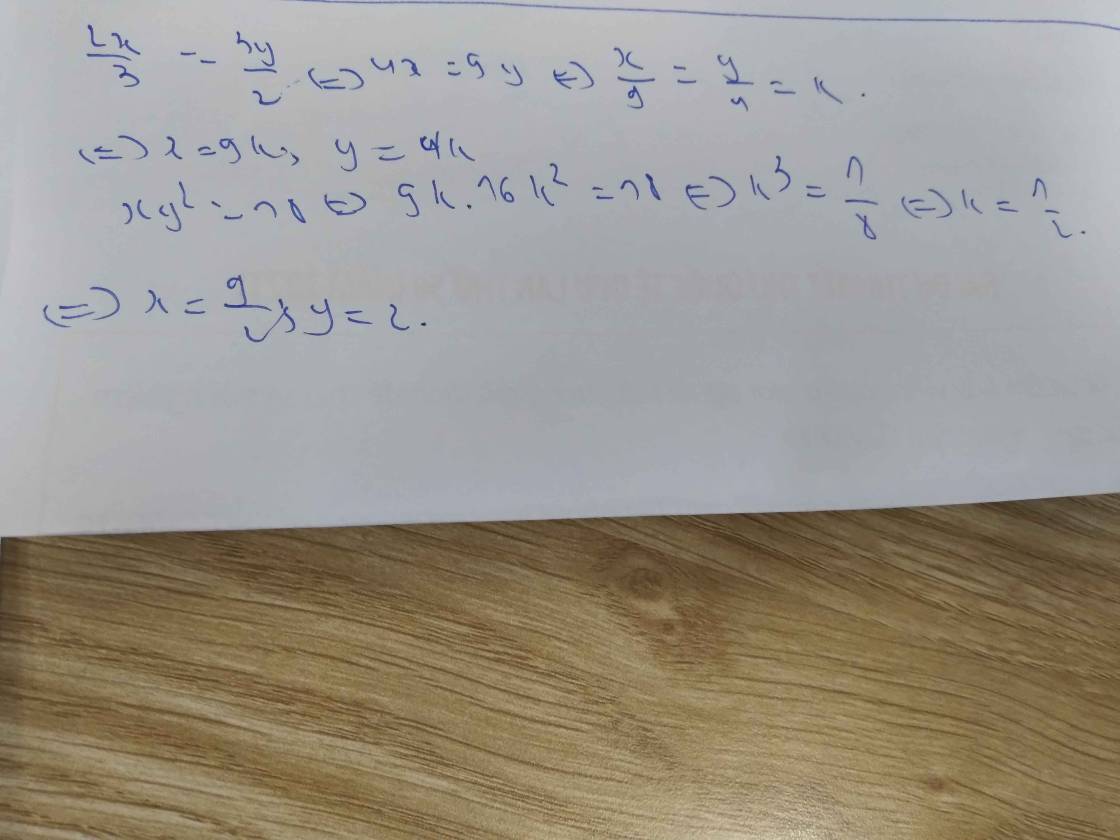

Hãy nhập câu hỏi của bạn vào đây, nếu là tài khoản VIP, bạn sẽ được ưu tiên trả lời.



Ta có :
\(\dfrac{x}{10}=\dfrac{y}{5}\Leftrightarrow\dfrac{x}{20}=\dfrac{y}{10}\)
\(\dfrac{y}{2}=\dfrac{z}{3}\Leftrightarrow\dfrac{y}{10}=\dfrac{z}{15}\)
\(\Leftrightarrow\dfrac{x}{20}=\dfrac{y}{10}=\dfrac{z}{15}\)
\(\Leftrightarrow\dfrac{2x}{40}=\dfrac{3y}{30}=\dfrac{4z}{60}\)
Áp dụng tính chất dãy tỉ số bằng nhau ta có :
\(\dfrac{2x}{40}=\dfrac{3y}{30}=\dfrac{4z}{60}=\dfrac{2x-3y+4z}{40-30+60}=\dfrac{330}{70}=\dfrac{33}{7}\)
\(\Leftrightarrow\left\{{}\begin{matrix}\dfrac{x}{20}=\dfrac{33}{7}\Leftrightarrow x=\dfrac{660}{7}\\\dfrac{y}{10}=\dfrac{33}{7}\Leftrightarrow y=\dfrac{330}{7}\\\dfrac{z}{15}=\dfrac{33}{7}\Leftrightarrow z=\dfrac{495}{7}\end{matrix}\right.\)
Vậy .....

Bài 1 :
Đặt :
\(\dfrac{2x}{3}=\dfrac{3y}{4}=\dfrac{4z}{5}=k\)
\(\Leftrightarrow\left\{{}\begin{matrix}2x=3k\\3y=4k\\4z=5k\end{matrix}\right.\) \(\Leftrightarrow\left\{{}\begin{matrix}x=\dfrac{3k}{2}\\y=\dfrac{4k}{3}\\z=\dfrac{5k}{4}\end{matrix}\right.\)
Thay vào \(x+y+z=49\) ta được :
\(\dfrac{3k}{2}=\dfrac{4k}{3}=\dfrac{5k}{4}=49\)
\(\Leftrightarrow\dfrac{18k+16k+15k}{12}=\dfrac{588}{12}\)
\(\Leftrightarrow49k=588\)
\(\Leftrightarrow k=12\)
\(\Leftrightarrow\left\{{}\begin{matrix}x=\dfrac{3.12}{2}=18\\y=\dfrac{4.12}{3}=16\\z=\dfrac{5.12}{4}=15\end{matrix}\right.\)
Vậy ....
Bài1:
Từ \(\dfrac{2x}{3}=\dfrac{3y}{4}=\dfrac{4z}{5}=\dfrac{x}{90}=\dfrac{y}{80}=\dfrac{z}{75}\)
Áp dụng t/c của dãy tỉ số bằng nhau,ta có:
\(\dfrac{x}{90}=\dfrac{y}{80}=\dfrac{z}{75}=\dfrac{x+y+z}{90+80+75}=\dfrac{49}{245}=\dfrac{1}{5}\)
=>x=18;b=16;c=15
Vậy...

1.
Đặt \(\dfrac{x}{5}=\dfrac{y}{4}=k\Rightarrow\left\{{}\begin{matrix}x=5k\\y=4k\end{matrix}\right.\)
\(\Rightarrow x^2-y^2=\left(5k\right)^2-\left(4k\right)^2=25k^2-16k^2=9k^2=4\)
\(\Rightarrow k^2=\dfrac{4}{9}\Rightarrow k=\pm\dfrac{2}{3}\)
\(\circledast k=\dfrac{2}{3}\Rightarrow\left\{{}\begin{matrix}x=\dfrac{10}{3}\\y=\dfrac{8}{3}\end{matrix}\right.\)
\(\circledast k=-\dfrac{2}{3}\Rightarrow\left\{{}\begin{matrix}x=-\dfrac{10}{3}\\y=-\dfrac{8}{3}\end{matrix}\right.\)
2.
Áp dụng tính chất của dãy tỉ số bằng nhau, ta có:
\(\dfrac{2x+1}{5}=\dfrac{3y-2}{7}=\dfrac{2x+1+3y-2}{5+7}=\dfrac{2x+3y-1}{12}=\dfrac{2x+3y-1}{6x}\)
\(\Rightarrow6x=12\Rightarrow x=2\)
\(\Rightarrow y=\dfrac{\dfrac{2\cdot2+1}{5}\cdot7+2}{3}=3\)
3.
\(\dfrac{x-1}{2}=\dfrac{y-2}{3}=\dfrac{z-3}{4}\Leftrightarrow\dfrac{2x-2}{4}=\dfrac{3y-6}{9}=\dfrac{z-3}{4}\)
Áp dụng tính chất của dãy tỉ số bằng nhau, ta có:
\(\dfrac{2x-2}{4}=\dfrac{3y-6}{9}=\dfrac{z-3}{4}=\dfrac{2x-2+3y-6-\left(z-3\right)}{4+9-4}=\dfrac{95-8+3}{9}=10\)
\(\Rightarrow\left\{{}\begin{matrix}x=\dfrac{10\cdot4+2}{2}=21\\y=\dfrac{10\cdot9+6}{3}=32\\z=10\cdot4+3=43\end{matrix}\right.\)

Em chỉ giải phần B thôi nhé !
x/4=y/3=x-y/4-3=x2-y2=42-32=28/7=4
Suy ra x/4=4 -> x= 16
y/3=4-> y =12
chị thông cảm em mói học lop 6 dung thi dung sai thi sai dung la em nha

Bài 1
a, \(D=1-\left|2x-3\right|\)
Ta có : \(\left|2x-3\right|\ge0\)
\(\Rightarrow1-\left|2x-3\right|\le1\)
Dấu "=" xảy ra khi \(\left|2x-3\right|=0\)
\(\Leftrightarrow2x-3=0\)
\(\Leftrightarrow2x=3\)
\(\Leftrightarrow x=3:2=\dfrac{3}{2}\)
\(b,\) Ta có : \(\left|10-5x\right|\ge0\Rightarrow\left|10-5x\right|+14,2\ge14,3\Rightarrow-\left|10-5x\right|-14,2\le-14,2\)
Dấu "=" xảy ra khi \(-\left|10-5x\right|=0\)
\(\Leftrightarrow10-5x=0\)
\(\Leftrightarrow5x=10\)
\(\Leftrightarrow x=10:5=2\)
Vậy \(Emax=-14,2\Leftrightarrow x=2\)
\(c,\) Ta có : \(\left|5x-2\right|\ge0\)
\(\left|3y-12\right|\ge0\)
⇒ \(\left|5x-2\right|+\left|3y+12\right|-4\ge-4\)
⇒ \(4-\left|5x-2\right|-\left|3y+12\right|\le4\)
Dấu "=" xảy ra khi \(\left[{}\begin{matrix}\left|5x-2\right|=0\\\left|3y+12\right|=0\end{matrix}\right.\)
\(\Leftrightarrow\left[{}\begin{matrix}5x=2\\3y=-12\end{matrix}\right.\)
\(\Leftrightarrow\left[{}\begin{matrix}x=\dfrac{2}{5}\\y=-4\end{matrix}\right.\)
\(d,\) \(A=5-3\left(2x-1\right)^2\)
Ta có : \(\left(2x-1\right)^2\ge0\)
\(\Rightarrow3.\left(2x-1\right)^2\ge0\)
\(\Rightarrow3.\left(2x-1\right)^2-5\ge-5\)
\(\Rightarrow5-3\left(2x-1\right)^2\le5\)
Dấu "=" xảy ra khi \(\left(2x-1\right)^2=0\)
\(\Leftrightarrow2x-1=0\)
\(\Leftrightarrow2x=1\)
\(\Leftrightarrow x=\dfrac{1}{2}\)
Vậy \(Amax=5\Leftrightarrow x=\dfrac{1}{2}\)

1) a) \(3x\left(x-\dfrac{2}{3}\right)=0\Leftrightarrow\left\{{}\begin{matrix}3x=0\\x-\dfrac{2}{3}=0\end{matrix}\right.\Leftrightarrow\left\{{}\begin{matrix}x=0\\x=\dfrac{2}{3}\end{matrix}\right.\)
vậy \(x=0;x=\dfrac{3}{2}\)
b) \(7\left(x-1\right)+2x\left(1-x\right)=0\Leftrightarrow7x-7+2x-2x^2=0\)
\(\Leftrightarrow\) \(-2x^2+9x-7=0\)
\(\Delta=9^2-4.\left(-2\right)\left(-7\right)=81-56=25>0\)
\(\Rightarrow\) phương trình có 2 nghiệm phân biệt
\(x_1=\dfrac{-9+5}{-4}=1\)
\(x_2=\dfrac{-9-5}{-4}=\dfrac{7}{2}\)
vậy \(x=1;x=\dfrac{7}{2}\)

Áp dụng tính chất dãy tỉ số bằng nhau, ta có:
\(\frac{x+1}{2}=\frac{y+3}{4}\)\(=\frac{z+5}{6}\)\(=\frac{2.\left(x+1\right)+3.\left(y+3\right)+4.\left(z+5\right)}{2.2+3.4+4.6}\)
\(=\frac{2x+2+3y+9+4z+20}{4+12+24}\)\(=\frac{\left(2x+3y+4z\right)+\left(2+9+20\right)}{40}\)
\(=\frac{9+31}{40}=\frac{40}{40}=1\)
Cứ thế là tìm x+1 rồi tìm x
y+3 y
x+5 z